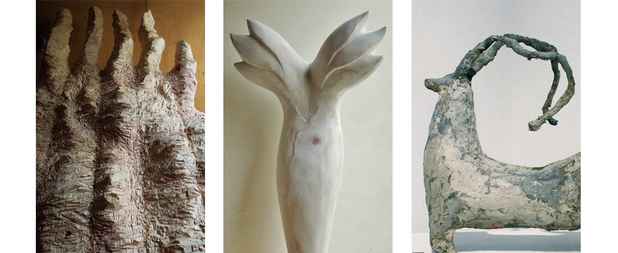Eisaku Ando + Hiroko Hasegawa + Taro Mizushima “Kangatari Myth”
Galerie Ashiya Schule

This event has ended.
After graduating from Tokyo University of the Arts, Eisaku Ando (b.1 961) moved to Iwaki-shi, Fukushima to produce sculptures in nature. Following the 2011 earthquake, he moved to Nara, where he creates rough-surfaced, curved-line wooden sculptures with an axe. He has exhibited his works at the Group Show of Contemporary Artists 2014 at the Tokyo Metropolitan Art Museum, the Water and Land Niigata Art Festival 2015, and Art for Life 2016 at the Taro Okamoto Museum of Art.
Hiroko Hasegawa (b.1961), Ando’s classmate at Tokyo University of the Arts, creates sculptures from the wood of cherry trees, hinoki cypress, and pines polished with whitewash. Those works remind us of fairies, birds, or fish, and emit the freshness of a newborn baby and gentle light.
Taro Mizushima (b.1979) learned the classic technique of Datsu-katsu-kannshitsu from his grandfather Hirokazu Mizushima and from his father Iwane Mizushima, both of whom were sculptors. The Datsu-katsu kanshitsu technique uses lacquer and tonoko clay with hemp cloth to create Buddhist statues. It was practiced from the seventh century to the end of the eighth century, but there have been few works made with this technique after the Nara era (710–794), since it requires expensive lacquer in large quantities and takes time for production. Mizushima has been participating in the Shuni-e (Omizu-tori) ceremony at Todai-ji Temple for more than a decade. He produces works as contemporary art with a classic technique.
Media
Schedule
from 3月 25, 2017 at 12:00 to 4月 23, 2017 at 18:00
Closes at 17:00 on the last day. Closed on Wednesday and Thursday.
Opening Reception on 2017-03-25 from 16:30